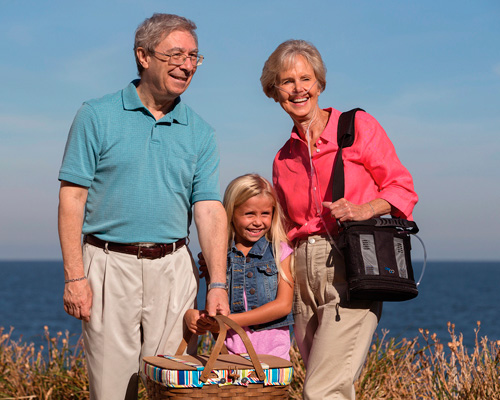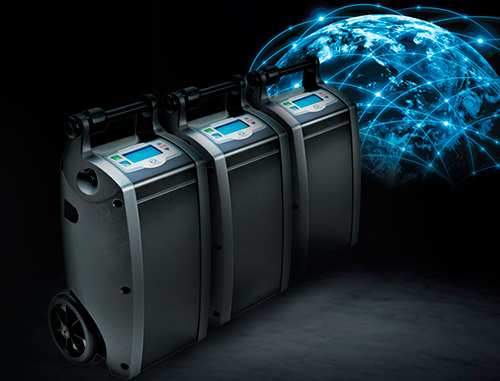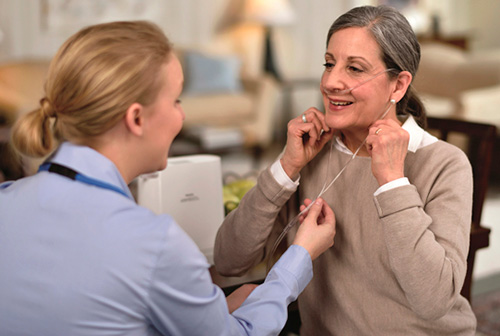Applied Home Healthcare Equipment
Dave Marquard, President and CEO applied-inc.com
 OxyGo POC
OxyGo POCTell us about your company.
MARQUARD: Applied Home Healthcare Equipment has a 23-year history of driving provider costs down with innovative products and services such as the OxyGo POC, OxyFill medical oxygen refilling systems, FlexRegs (all-in-one oxygen regulators with 0.5 to 15 lpm settings), OxySafe oxygen firestops and online and on-site training.
Where is the oxygen market heading?
MARQUARD: We believe providers can thrive with non-delivery models such as OxyGo and new business opportunities such as OxyFill oxygen refilling systems. Both systems reduce provider costs.
Will there be any challenges associated with these changes?
MARQUARD: We think there will be more providers moving to non- and reduced-delivery models to control costs and increase profitability.
How is your company staying competitive this year?
MARQUARD: We introduced a host of new products, services and concepts, all designed to drive provider costs down. Examples include the OxyGo POC non-delivery model, which lowers medical oxygen costs through lower training costs and better compliance.
Where does customer interaction fit in?
MARQUARD: Customer service, education and oxygen product knowledge are the best indicators of future provider profitability. However, providers cannot do it alone; they have to partner with quality suppliers who have a culture of customer service and product education.
Drive DeVilbiss Healthcare
Mitchell Yoel, Executive VP, Business Development drivemedical.com
 iGo Walking Concentrator
iGo Walking ConcentratorWhat is your company known for in this industry?
YOEL: Drive DeVilbiss Healthcare provides a robust suite of oxygen technologies and solutions. Drive released the Pure O2 5 Liter concentrator with both OCI and non-OCI options several months ago, and it is off to an incredible start. To complement our conservers and our newly released concentrator, Drive unveiled the PureFill Oxygen System at Medtrade. This non-delivery system will complete our 360-degree oxygen solution. The recent acquisition of DeVilbiss Healthcare adds to the excitement around our momentum.
What is the forecast for 2016?
YOEL: The industry could go two ways. One: continue to reinforce the notion that selection of oxygen technology doesn't matter, and continue to choose modalities based on acquisition cost and operational cost savings. Two: disrupt the perception that patients, referral sources and clinicians have of what the role of the DME provider should be in the health care continuum. Providers should be the experts who determine which oxygen delivery technology will best achieve clinical and quality of life goals.
How is Drive meeting the challenges?
YOEL: DME providers are the experts in the health care supply chain at matching technologies to post-acute care patients. To remain relevant, we'll need to overcome reimbursement cuts and audits. Providers who use oxygen solutions that are proven, rather than simply packaged nicely, will win the day. Perhaps most exciting is the data we will offer to the industry on how much selection of oxygen technology informs clinical outcome. We've invested in an IRB-approved clinical study on 30 patients, as well as third-party bench testing on different oxygen modalities and technologies. Providers will be able to use this data to approach key decision makers at referral sources to change perceptions and rebrand the role of the DME provider.
O2 Concepts
Rob Kent, CEO o2-concepts.com
 The Oxlife Independence
The Oxlife IndependenceWhat is O2 Concepts known for?
KENT: We offer a dual-mode POC capable of continuous flow up to 3LPM. We are the only company in the market advocating 24/7 use without a stationary, and we are seeing unparalleled reliability. This year we've integrated our devices over the Verizon network, with our DNA Technology (Dynamic Network Analysis). This allows oxygen providers to monitor all devices remotely for location, usage and performance, as well as troubleshoot.
Where is the oxygen market headed?
KENT: We are seeing a divergence in the market with equipment manufacturers. Some will aggressively drive cost out of product, focusing on price point alone, where our company and a handful of others will look to create better total-cost solutions. For example, our 24/7 reliability will allow providers to set up equipment anywhere in 15 minutes.
What will your industry have to grapple with in 2016?
KENT: The second round of competitive bidding and standardized rates in non-competitive bid areas is going to be a challenge. If your business hasn't mastered non-delivery before it hits, it's going to be even tougher to implement when reimbursements get tighter. Providers need to adopt non-delivery across the board with POCs, and have the retail prowess to up sell accessories.
How are you staying competitive?
KENT: In addition to the 24/7 reliability, we can maximize reimbursements by billing both E1390 and E1392 on one machine. Our DNA Technology allows for monitoring equipment usage and data such as oxygen flow, purity, device hours and more—all in real time.
Philips Respironics
Eli Diacopoulos, GM, Respiratory Care respironics.com
 SimplyGo Mini
SimplyGo MiniWhat makes your products stand out?
DIACOPOULOS: All of our products are designed to meet or exceed the needs of the patient based on lifestyle. Our technology is durable and quiet, so patients feel more comfortable.
What are the current market trends?
DIACOPOULOS: Due to continued adoption of POCs, growth acceleration is happening with more than 1.5 million patients using home oxygen; the industry is ripe for innovation. Also, more patients are getting a diagnosis earlier in the disease process, particularly COPD, which means we have a much larger population of active patients. We're going to see more partnerships between health systems and homecare providers in response to the readmission penalties.
How will Philips face the challenges?
DIACOPOULOS: Continued reimbursement declines put tremendous pressure on DME providers to be efficient and minimize the need for unexpected patient service. We must continue to make products that are durable, intuitive and require little maintenance.
What products or technologies are you excited about this year?
DIACOPOULOS: One of our newer products, SimplyGo Mini, is a POC for patients who lead more active lifestyles. It's the smallest and lightest in our portfolio, so patients can easily take it wherever they go.
Where are opportunities for providers to become more successful this year?
DIACOPOULOS: To be successful in today's healthcare world, HMEs need to recognize the increased role patients are playing. They are more engaged and informed, and are contributing more financially to ensure they have the products that fit into their lifestyles.
